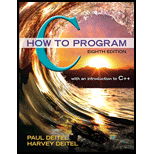
(Supermarket Simulation) Write a program that simulates a check-out line at a supermarket. The line is a queue. Customers arrive in random integer intervals of 1 to 4 minutes. Also, each customer is serviced in random integer intervals of 1 to 4 minutes. Obviously, the rates need to be balanced. If the average arrival rate is larger than the average service rate, the queue will grow infinitely. Even with balanced rates, randomness can still cause long lines. Run the supermarket simulation for a 12-hour day (720 minutes) using the following
A. Choose a random integer between 1 and 4 to determine the minute at which the first customer arrives.
B. At the first customer’s arrival time:
Determine customer’s service time (random integer from 1 to 4);
Begin servicing the customer;
Schedule arrival time of next customer (random integer 1 to 4 added to the current time).
C. For each minute of the day:
If the next customer arrives,
Say so;
Enqueue the customer;
Schedule the arrival time of the next customer.
If service was completed for the last customer,
Say so;
Dequeue next customer to be serviced;
Determine customer’s service completion time (random integer from 1 to 4 added to the current time).
Now run your simulation for 720 minutes and answer each of the following:
- What’s the maximum number of customers in the queue at any time?
- What’s the longest wait any one customer experienced?
- What happens if the arrival interval is changed from 1 to 4 minutes to 1 to 3 minutes?
Want to see the full answer?
Check out a sample textbook solution
Chapter 12 Solutions
C How To Program Plus Mylab Programming With Pearson Etext -- Access Card Package (8th Edition)
Additional Engineering Textbook Solutions
Introduction To Programming Using Visual Basic (11th Edition)
Thinking Like an Engineer: An Active Learning Approach (4th Edition)
Starting Out with Python (4th Edition)
INTERNATIONAL EDITION---Engineering Mechanics: Statics, 14th edition (SI unit)
Starting Out With Visual Basic (8th Edition)
Problem Solving with C++ (10th Edition)
 C++ for Engineers and ScientistsComputer ScienceISBN:9781133187844Author:Bronson, Gary J.Publisher:Course Technology Ptr
C++ for Engineers and ScientistsComputer ScienceISBN:9781133187844Author:Bronson, Gary J.Publisher:Course Technology Ptr C++ Programming: From Problem Analysis to Program...Computer ScienceISBN:9781337102087Author:D. S. MalikPublisher:Cengage Learning
C++ Programming: From Problem Analysis to Program...Computer ScienceISBN:9781337102087Author:D. S. MalikPublisher:Cengage Learning Operations Research : Applications and AlgorithmsComputer ScienceISBN:9780534380588Author:Wayne L. WinstonPublisher:Brooks Cole
Operations Research : Applications and AlgorithmsComputer ScienceISBN:9780534380588Author:Wayne L. WinstonPublisher:Brooks Cole EBK JAVA PROGRAMMINGComputer ScienceISBN:9781337671385Author:FARRELLPublisher:CENGAGE LEARNING - CONSIGNMENTProgramming Logic & Design ComprehensiveComputer ScienceISBN:9781337669405Author:FARRELLPublisher:Cengage
EBK JAVA PROGRAMMINGComputer ScienceISBN:9781337671385Author:FARRELLPublisher:CENGAGE LEARNING - CONSIGNMENTProgramming Logic & Design ComprehensiveComputer ScienceISBN:9781337669405Author:FARRELLPublisher:Cengage Microsoft Visual C#Computer ScienceISBN:9781337102100Author:Joyce, Farrell.Publisher:Cengage Learning,
Microsoft Visual C#Computer ScienceISBN:9781337102100Author:Joyce, Farrell.Publisher:Cengage Learning,





